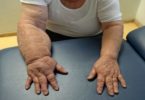What's in this article?
Breast lumps are common and have a number of different causes.
Although most lumps aren’t breast cancer, any unusual changes to the breasts should be checked by a GP as soon as possible. If your GP finds a lump on examination, they will routinely refer you to be seen by a hospital specialist.
There are several types of benign (non-cancerous) breast lump, most of which are harmless and are caused by hormonal changes that occur at different times in a woman’s life, such as during the menstrual cycle.
Common types of benign breast lump include:
- a fibroadenoma: a firm lump that moves around easily in the breast and is more common in younger women
- a breast cyst: a smooth, firm fluid-filled lump most commonly seen in women aged 30 to 60
- a breast abscess: a painful collection of pus that forms under the skin of the breast, usually as the result of a bacterial infection
Breast lumps facts
- Breast lumps can be caused by infections, injuries, non-cancerous growths, and cancer.
- Breast cancer usually causes no pain in the breast. The symptoms of breast cancer include painless breast lumps, nipple discharge, and inflammation of the skin of the breast.
- The chances that a particular breast lump could be cancerous depends on many factors, including past medical history, physical examination, as well as genetic and other risk factors.
- The only way to be certain that a lump is not cancerous is to have a tissue sampling (biopsy). There are several ways to do the biopsy. The treatment of a breast lump depends on its cause.
Causes of breast lumps
Most breast lumps are caused by benign (non-cancerous) conditions, although occasionally a breast lump can be a symptom of breast cancer.
It’s important to see your GP as soon as possible if you notice a lump in your breast so they can refer you for tests to confirm the cause.
Diagnosing a breast lump
It is important to be aware of how your breasts usually look and feel so you can quickly pick up on any changes that may occur.
See your GP if you notice a lump in your breast or any change in its appearance, feel or shape. Your GP may ask a number of questions, including:
- When did you first noticed the lump?
- Do you have other symptoms, such as pain or a discharge from your nipple?
- Do your symptoms change with your menstrual cycle?
- Have you ever injured your breast?
- Do you have any risk factors for breast cancer, such as a close family member who has had breast cancer?
- What medications are you currently taking?
- Are you currently breastfeeding, or have done in the past?
Your GP will also carry out a physical examination of both your breasts, with your permission.
How are breast lumps treated?
- A breast infection (mastitis) in a breastfeeding woman is treated with warm compresses and antibiotics.
- A convenient and effective way of applying heat treatment is to wet some washcloths and put them in the microwave briefly to warm them.
- Hot showers are also helpful.
- During heat treatment, the infected area can be massaged.
- After heat treatment, which helps open up the milk ducts, either nursing the baby or using a breast pump can help relieve the swelling and pain. Contrary to common myth, nursing the baby or using a breast pump is a critical part of the treatment because it helps decrease the chance of the infection progressing.
If the area actually looks red or fails to get better with heat, massage, and nursing, a doctor should be consulted for consideration of antibiotics. If untreated, mastitis can quickly progress and develop into a severe infection. Whether a woman is pregnant or not, she needs to see a doctor if the area does not return completely to normal with treatment in order to rule out more unusual types of infections.
Checking for breast lumps
It is important for women to be familiar with their bodies and their breasts. Knowing how the breasts normally feel can help to recognize any problematic changes or lumps.

A self examination is recommended for each woman, every month.
The following guidelines will help:
- Looking in a mirror, check the size, shape, and color and look for visible swellings or lumps
- Raise the arms and repeat step 1
- Check for any discharge from the nipples that may be watery, milky, yellow, or with blood
- Feel the breasts with a firm, smooth motion while lying down, including under the arms and down to the ribcage
- Repeat step 4 while standing or sitting, It may be easier in the shower
Even though most breast lumps are benign, anything unusual should be checked by a doctor.






Leave a Comment